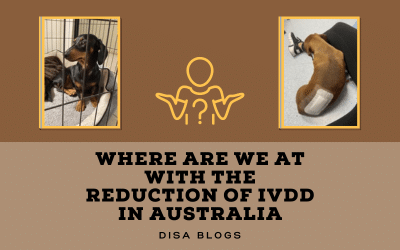Let’s be honest, progress in reducing the incidence of Intervertebral Disc Disease (IVDD) in Dachshunds across Australia has been frustratingly slow. Despite DISA’s ongoing efforts to raise awareness through its website and social media, the lack of substantial community-wide action is deeply concerning.
A Sobering Reality Check
While awareness is growing, and more Dachshund owners are learning about the risks of IVDD, what’s missing is coordinated, large-scale action. Current efforts to prevent or reduce IVDD are still fragmented and insufficient.
What Needs to Change?
Key players in the community have either overlooked or misunderstood the critical importance of addressing IVDD as a genetic condition. Tackling its root causes requires a unified, grassroots effort. This lack of cohesion weakens the potential for a strong, collective movement. It’s crucial that we come together and strengthen our approach to effectively confront this issue.
Here’s What That Could Look Like:
- Unified Campaigns: Picture a national IVDD prevention week, supported by breeders, breed clubs, Dachshund charities, and more. With consistent messaging, we could reach a wider audience and make a real impact.
- Breeder Accountability: Encouraging breeders to prioritise spinal health in their programs and educating buyers on responsible choices could gradually reduce IVDD cases.
- Breed Clubs Promoting X-Ray Screening and Back Scoring: This practice has been used in Scandinavia for years and remains the best tool available to reduce the genetic risk of IVDD. It’s time for Australia to follow suit.
Stop the Blame Game!
For the past five years, DISA has led the social media campaign “Let the Breeder Know,” which has revealed a worrying lack of awareness among pet owners about what defines an ethical breeder. When confronted, many breeders dismissed concerns with comments like “Never had it happen before” or “You probably caused it.” Owners often remarked, “My breeder provided a DNA test stating my dog has been tested for IVDD.” But what does that really mean? Read the current update here: CDPA/CDDY DNA Testing for IVDD in Dachshunds – update August 2024. Some breeders appear to use genetic testing as a false reassurance, leaving both pet owners and breeders trapped in a cycle that fails to address the root causes of IVDD. The deceptive practices of backyard breeders, combined with widespread misunderstanding among owners, perpetuate the problem without leading to meaningful solutions.
Looking Ahead
If we want to reduce IVDD cases, ignoring the problem won’t cut it. The Australian Dachshund community must unite, share resources, and take proactive, coordinated action. The road ahead may be challenging, but with determination and collective effort, we can pave the way for a healthier future for our beloved Dachshunds.
Final Words
DISA has advocated for change for ten years and now finds itself at a standstill. While a select group of AKNC breeders have made strides by X-ray screening and scoring their Dachshunds between 24-48 months of age, broader progress remains elusive. The ongoing reluctance to make tough decisions and take meaningful action continues to impede efforts to reduce IVDD in Australia.
Despite these challenges, DISA remains dedicated to supporting owners of IVDD-affected hounds and promoting awareness and education for current and prospective owners.
Date: September 2024

